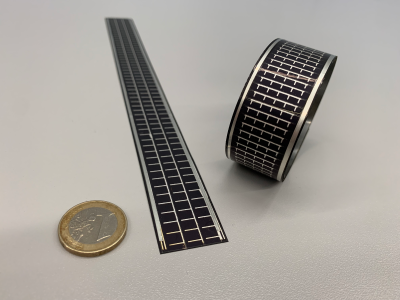A Consumable-less Propulsion System Based on a Bare-Photovoltaic Tether

As proved in several missions, the Lorentz force acting on the electric current carried by a space electrodynamic tether (EDT) can be used to propel spacecraft without using propellant. State-of-the-art EDTs involve a bare tape for passive electron collection (anodic contact) and an active device, or a tether segment coated with a low-work-function material, for electron emission (cathodic contact). A tether segment made of thin film solar cells interposed between the anodic and the cathodic contacts improves tether performances while opening the possibility of using consumable-less electron emitters, like thermionic and electron field emitters. The photovoltaic segment harvests power from the Sun passively and injects it in the tether-plasma circuit.
Consequently, the proposed architecture eliminates the design dilemma of state-of-the-art tethers: use consumable-less cathodes and low currents or choose a hollow cathode, which needs expellant, and reach high currents. A detailed analysis of the current and voltage profiles along the tether shows that, if tether dimensions are designed correctly, consumable-less cathodes and high currents are possible thanks to the power delivered by the photovoltaic segment. Since thin-film solar cells can be folded and manufactured with any desired length and the same cross-section dimensions as the bare segment, the full bare-photovoltaic tether can be stored in a deployment mechanism, thus yielding a compact device for in-orbit propulsion. Although both passive and active modes are possible, and therefore spacecraft de-orbiting and re-boost, the most natural application of the idea is the development of a light, autonomous, and consumable-less device for deorbiting satellites at the end-of-life.
The goal of this project was to demonstrate the feasibility of Bare Photovoltaic Tethers (BPT) and assess its potential impact on EDT technology. To achieve it, the following objectives were proposed:
- Identify the most promising photovoltaic technology and make an electrical and mechanical design of the bare-photovoltaic tether.
- Demonstrate the feasibility of the BPT by performing a detailed electrical and mechanical characterisation.
- Incorporate a bare-photovoltaic model into a mission analysis software and study its performance.
